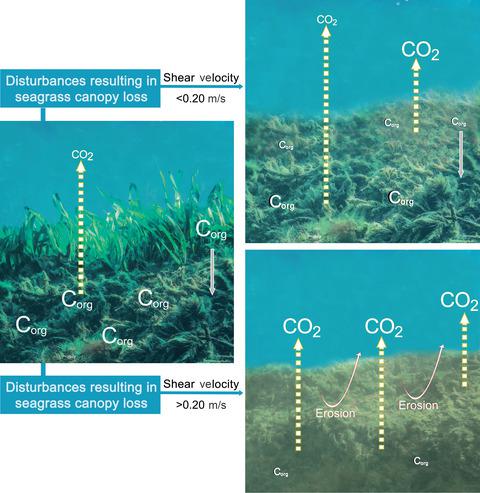当前位置:
X-MOL 学术
›
Glob. Change Biol.
›
论文详情
Our official English website, www.x-mol.net, welcomes your feedback! (Note: you will need to create a separate account there.)
Seagrass losses since mid-20th century fuelled CO2 emissions from soil carbon stocks.
Global Change Biology ( IF 11.6 ) Pub Date : 2020-07-07 , DOI: 10.1111/gcb.15204 Cristian Salinas 1 , Carlos M Duarte 2 , Paul S Lavery 1 , Pere Masque 1, 3, 4 , Ariane Arias-Ortiz 4, 5 , Javier X Leon 6 , David Callaghan 7 , Gary A Kendrick 8, 9 , Oscar Serrano 1
Global Change Biology ( IF 11.6 ) Pub Date : 2020-07-07 , DOI: 10.1111/gcb.15204 Cristian Salinas 1 , Carlos M Duarte 2 , Paul S Lavery 1 , Pere Masque 1, 3, 4 , Ariane Arias-Ortiz 4, 5 , Javier X Leon 6 , David Callaghan 7 , Gary A Kendrick 8, 9 , Oscar Serrano 1
Affiliation

|
Seagrass meadows store globally significant organic carbon (Corg) stocks which, if disturbed, can lead to CO2 emissions, contributing to climate change. Eutrophication and thermal stress continue to be a major cause of seagrass decline worldwide, but the associated CO2 emissions remain poorly understood. This study presents comprehensive estimates of seagrass soil Corg erosion following eutrophication‐driven seagrass loss in Cockburn Sound (23 km2 between 1960s and 1990s) and identifies the main drivers. We estimate that shallow seagrass meadows (<5 m depth) had significantly higher Corg stocks in 50 cm thick soils (4.5 ± 0.7 kg Corg/m2) than previously vegetated counterparts (0.5 ± 0.1 kg Corg/m2). In deeper areas (>5 m), however, soil Corg stocks in seagrass and bare but previously vegetated areas were not significantly different (2.6 ± 0.3 and 3.0 ± 0.6 kg Corg/m2, respectively). The soil Corg sequestration capacity prevailed in shallow and deep vegetated areas (55 ± 11 and 21 ± 7 g Corg m−2 year−1, respectively), but was lost in bare areas. We identified that seagrass canopy loss alone does not necessarily drive changes in soil Corg but, when combined with high hydrodynamic energy, significant erosion occurred. Our estimates point at ~0.20 m/s as the critical shear velocity threshold causing soil Corg erosion. We estimate, from field studies and satellite imagery, that soil Corg erosion (within the top 50 cm) following seagrass loss likely resulted in cumulative emissions of 0.06–0.14 Tg CO2‐eq over the last 40 years in Cockburn Sound. We estimated that indirect impacts (i.e. eutrophication, thermal stress and light stress) causing the loss of ~161,150 ha of seagrasses in Australia, likely resulted in the release of 11–21 Tg CO2‐eq since the 1950s, increasing cumulative CO2 emissions from land‐use change in Australia by 1.1%–2.3% per annum. The patterns described serve as a baseline to estimate potential CO2 emissions following disturbance of seagrass meadows.
中文翻译:

自20世纪中叶以来海草的损失加剧了土壤碳储量的二氧化碳排放量。
海草草甸在全球范围内存储大量的有机碳(C org)储备,如果受到干扰,会导致CO 2排放,从而导致气候变化。富营养化和热应激仍然是全世界海草数量下降的主要原因,但是与之相关的CO 2排放仍然知之甚少。这项研究提出了在Cockburn Sound(1960年代至1990年代之间23 km 2)富营养化驱动的海草流失后海草土壤C org侵蚀的综合估计,并确定了主要驱动力。我们估计,在50 cm厚的土壤中(4.5±0.7 kg C org / m 2)浅海草草甸(深度小于5 m)的C org储量明显较高。)比以前的植被(0.5±0.1 kg C org / m 2)高。然而,在更深的地区(> 5 m),海草和裸露但先前已植被的地区的土壤C org储量没有显着差异(分别为2.6±0.3和3.0±0.6 kg C org / m 2)。土壤C org的固存能力主要分布在浅植物区和深植被区(分别为55±11 g C org m - 2 年- 1年和21±7 g C org m - 2年-1),而在裸露的地区则消失了。我们发现仅海草冠层损失并不一定驱动土壤C org的变化。但是,当结合高动能时,就会发生严重的侵蚀。我们的估计值约为0.20 m / s,它是引起土壤C org侵蚀的临界剪切速度阈值。通过实地研究和卫星图像,我们估计,海草流失后土壤C org侵蚀(在顶部50厘米以内)很可能导致了过去40年里,库克本峡的累积排放量为0.06-0.14 Tg CO 2当量。我们估计,间接影响(即富营养化,热应力和光应力)在澳大利亚造成约161,150公顷海草损失,很可能导致1950年代以来释放11–21 Tg CO 2当量,从而增加了累积CO 2澳大利亚土地利用变化带来的排放每年增加1.1%–2.3%。所描述的模式用作基线,以估计海草草甸受到干扰后的潜在CO 2排放。
更新日期:2020-08-11
中文翻译:

自20世纪中叶以来海草的损失加剧了土壤碳储量的二氧化碳排放量。
海草草甸在全球范围内存储大量的有机碳(C org)储备,如果受到干扰,会导致CO 2排放,从而导致气候变化。富营养化和热应激仍然是全世界海草数量下降的主要原因,但是与之相关的CO 2排放仍然知之甚少。这项研究提出了在Cockburn Sound(1960年代至1990年代之间23 km 2)富营养化驱动的海草流失后海草土壤C org侵蚀的综合估计,并确定了主要驱动力。我们估计,在50 cm厚的土壤中(4.5±0.7 kg C org / m 2)浅海草草甸(深度小于5 m)的C org储量明显较高。)比以前的植被(0.5±0.1 kg C org / m 2)高。然而,在更深的地区(> 5 m),海草和裸露但先前已植被的地区的土壤C org储量没有显着差异(分别为2.6±0.3和3.0±0.6 kg C org / m 2)。土壤C org的固存能力主要分布在浅植物区和深植被区(分别为55±11 g C org m - 2 年- 1年和21±7 g C org m - 2年-1),而在裸露的地区则消失了。我们发现仅海草冠层损失并不一定驱动土壤C org的变化。但是,当结合高动能时,就会发生严重的侵蚀。我们的估计值约为0.20 m / s,它是引起土壤C org侵蚀的临界剪切速度阈值。通过实地研究和卫星图像,我们估计,海草流失后土壤C org侵蚀(在顶部50厘米以内)很可能导致了过去40年里,库克本峡的累积排放量为0.06-0.14 Tg CO 2当量。我们估计,间接影响(即富营养化,热应力和光应力)在澳大利亚造成约161,150公顷海草损失,很可能导致1950年代以来释放11–21 Tg CO 2当量,从而增加了累积CO 2澳大利亚土地利用变化带来的排放每年增加1.1%–2.3%。所描述的模式用作基线,以估计海草草甸受到干扰后的潜在CO 2排放。


























 京公网安备 11010802027423号
京公网安备 11010802027423号